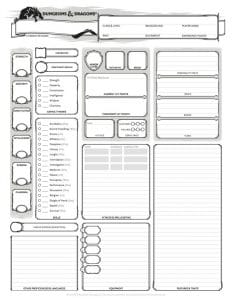A typical D&D character sheet has a ____________ for height and weight, but in terms of creating an interesting character, those physical attributes are about as helpful as wondering if your D&D character were a piece of Ikea furniture what piece would she be.
The answer to that is obvious…Kallax bookshelves because a 2×2 Kallax unit weighs (packed) just 41 lbs with interior cubby dimensions of 13 1/4 inches x 13 1/4 inches, which is perfect for my Zombicide board games, and I don’t want to be surrounded by a nincompoop who says it is Ikea’s Billy bookcase, although I will entertain arguments that support the Skjarnngflong.
See why physical attributes are only part of the story? Now, back to the topic: What makes an interesting and memorable D&D character, not just one that focuses on physical attributes?
Well, the answer is an alchemist’s brew of problems, ideals, conflicts, values, bonds, limitations, complications, fears, and adventuring potential. Now, if you are familiar with D&D 5e, you’ll realize that the designers baked some of these things into the mechanics of the game, going so far as placing it front-and-right on the character sheet.
How to Create D&D Characters that are Memorable

Download a D&D 5e character sheet. Assuming you have nice broadband and aren’t experiencing the Comcast issues I am, I have the time to wait.
Now, cast your gaze toward the upper right of the character sheet. The four boxes for Personality Traits, Ideals, Bonds, and Flaws serve as simple beginner tools for creating great D&D characters, so let’s start there, before we end this article on the really good stuff.
D&D Personality Traits
First are Personality Traits. As we opened, this can be the least interesting in terms of fleshing out a character. You might as well focus on Ikea furniture type (seriously, it’s Kallax) if you keep this strictly utilitarian. “My character talks British and dresses well.” ZZZ-Zzzz-ZZzzz-hngGGggh-Ppbhww- zZZzzzZZ…
No, make sure the personality traits are quirky (here’s a table to help you with quirks)! Sure, mark your hair color and note their fashion choices, being that we absolutely do need a visual thumbprint of the character so folks around the table can picture the character in their mind.
But if you want that visual thumbprint to be pushed hard into the squishy grey matter of the other player’s memories, you need to find the things that make the character visually unique, interesting, quirky, odd, curious — different.
Listen, I’m not talking weird for weird’s sake, because that just screams attention-seeking, but this is fantasy. There is no reason to have have unmemorable personality traits. Treat the tables from the character backgrounds included in the Players Handbook as more than a starting point. Push them further, Nerds, and turn them slightly askew.
D&D Ideals
Many have criticized alignment in Dungeons and Dragons, but I’m a fan. I strongly feel that determining what a character’s Ideals are is important.
What does your character stand for? Will they hold it together when they realize they can’t find gluten-free muffins in Waterdeep?
Basically, if the party’s cleric cares only about looting corpses for copper pieces, then it’s time to find another line of work. And in a stroke of irony, a character’s ideals can be a limitation for them. These ideals should create conflict within the character, potentially limiting them in some way, as they may have to alter course as adventures are thrown at them.
If your paladin has a “code of honor” then those ideals should limit him from acting dishonorably. This offers new plot angles and opportunities for tension, since the villains won’t be afraid to cross those same lines that the Paladin won’t.
Ideals might get in the way, even as they help paint a portrait of their heroism. Will the character stand by their deepest beliefs or not? Alignment matters. Us real folk wrestle in this way, so we should wrestle with it at the gaming table as well.
D&D Bonds
Bonds gets really interesting as they represent the people, places, or things that anchor or entangle the character. They also provide great adventure hooks for the DM.
Who does the character love? What places are most meaningful to her? Has he sworn allegiance to another? Is there a bounty on her head? Does he have a lost child? Bonds are a wonderful tool in creating great D&D characters. They can drive the character, while also ripping them to shreds.
More on bonds below.
D&D Flaws
Finally, we come to Flaws. These can be physical flaws, like your pirate rogue has a hook hand and struggles with two-handed weapons. But it’s best if they are character flaws, not physical flaws.
Bruce Willis’ flaw in Die Hard wasn’t that he was too sissy to deal with terrorists or handle a little broken glass like a yippie-kay-ay cowboy. His flaw was that he was more married to his job than he was to his wife, which opened the door to the entire conflict on the movie. Gosh, I love Die Hard.
Chris Farley’s flaw in Tommy Boy wasn’t that it took him 7 years to get through college, it’s that he didn’t have the confidence to realize he was all the salesman his father was, which opened the door to 90 minutes of high-jinx. Gosh, I love Tommy Boy.
But my favorite use of the flaw mechanic in D&D 5e is to highlight their greatest fear. What does the character fear most? Love. Disease. Bees. Toddlers. Chimpanzees with clown makeup. Lady Gaga. Whatever.
It’s useful to identify the character’s fear — meaning, the thing they least want to encounter or see happen — because as the story unfolds, and if the DM is rightfully mischievous, there is now this awful thing that can be brought out of it’s demon-box to threaten the character, seeing which way she jumps.
Before We Go: The Backstory!
So, yeah, use those four little boxes that might seem like an afterthought on a D&D 5e character sheet. Just remember, you don’t make characters on the fly; they are a long-bubbling broth that work best if they have a simple backstory.
“Simple” is the keyword there. Don’t write a convoluted and complicated 1,000 pages of fanfic. Complexity is the enemy of clarity. Remember, you want to focus on the adventuring that is ahead of you, not anchor your character down in what was behind them.
So, before that first play date, I’d encourage you to take your character through a 5-step story process to create their backstory. I’m super serious about this.
STEP 1 Your character…
STEP 2 had a problem,
STEP 3 then met a GUIDE…
STEP 4 who gave them a plan…
STEP 5 that called them to action.
Notice how just a simple few backstory touchpoints provide a clear narrative that provides high and lows that can hook you in wonderfully to pretty much any roleplaying campaign.
Consider the above with Luke Skywalker: Luke Skywalker had a problem – the evil Empire – yet met a guide, Obi-Wan Kenobi, who taught him to trust in the Force, a plan Luke carried with him as he joined the Rebellion to destroy the Death Star.
And from Tommy Boy, the crown jewel of cinema (fight me). Tommy had a problem when his dad died. But Richard knew the business and would guide Tommy as he took over sales for Callahan Auto. Tommy is called into action as he went on a sales trip to save his dad’s business. Hijinks ensued.

So, this 5 STEP process to write a character backstory works, Nerds, especially when you consider that the “guide” is synonymous with D&D 5e’s Bond, tying the processes together. It’s simple, yet effective, and brief enough to write in the margin of a paper character sheet, since it’s can be as tight as a single sentence.
I’ve written a much more detailed description of this 5-step backstory creation tool. Read it here. I’m very serious about this.
If you follow the above your character will be thoroughly and amazingly memorable. Most importantly, they’ll be a heaping-heck of a lot of fun to play.


